
The Breed History
The Afghan Hound was first represented in Indian works of art
dated 1809. The origin of the breed as the name implies was in
Afghanistan and surrounding regions where they were bred for at
least a few thousand years by nomadic tribes. Due to the variations
of elevation and climate in this harsh wild region, some variation
in breed type evolved, distinguishing it from the original Middle
Eastern Sight hound. The specimens that became foundation stock
for American and European breeding programs arrived in Scotland
in 1920 (desert strain), and specimens from the other founding
strain (mountain type) arrived in England in 1925. The AKC
admitted the breed in 1926.
Breeding for Function
The mountain regions of the north gave rise to Afghans with
heavier coats, more compact build and darker coat colors. The arid
regions gave rise to a lighter build and color and a less dense coat.
Historically this breed was a guard dog, a coursing hound, and
even reportedly used for herding. As a coursing sight hound, the
dog hunted alongside horsemen. Due to their speed and stamina
they often worked ahead of the hunters and due to their agility,
they were able to manage hunts over very rough terrain. The quarry
varied depending on the locale, and may have included antelope
and leopards. More recently, Afghan Hounds have been successfully
entered in lure coursing and obedience, but many are now prized
solely for their exceptional companionship qualities.
Physical Characteristics
Height at Withers: female 24-26" (61-66 cm), male 26-28" (66-71 cm).
Weight: females 50 lb (23 kg), males 60 lb (27 kg).
Coat: The very fine silky, glossy and long haircoat is shorter on
the face, though a long, soft topknot is present. Hair is short also
over the topline (the Afghan saddle) in adults. They are shown
in a natural unclipped coat. Though all coat colors are accepted
except spotted pattern, the presence of white head markings is not
encouraged. Puppies have soft fuzzy short hair on their saddles and
faces (monkey whiskers) that is replaced by an adult coat at about
one year of age.
Longevity: 12-14 years
Points of Conformation: This breed is noted for the "far-seeing
gaze", noble carriage and fine coat. Other key characteristics
include prominent hip bones, large feet, and they appear to have
an increased stifle angle due to the overlying haircoat. The skull is
long and finely chiseled with a slight Roman nose; no pronounced
stop is present. The occipital protuberance is prominent, the ears
are long and pendulous and covered with long silky hair, and the
leather is fine. Eyes are dark, almond-shaped, and almost triangular.
The muzzle is very long in this dolichocephalic breed. The nose is
moderate in size and black in pigmentation. Neck is long, arched,
and the topline is level, though the loin is slightly arched, and
there is a marked tuck-up in the abdomen. The thorax is deep,
the forelegs straight boned and the radius is very long; tibia is
also long, and the feet are well arched with lots of hair covering
them, and large toes are present. Their gait is smooth, elastic, and
high stepping with strides that cover great distance and seeming
effortless. High head and tail carriage is notable. The tail is low set,
curled at the end (donut tipped), and has minimal feathering.
Recognized Behavior Issues and Traits
Traits ascribed to this breed include: Strong independent streak,
strong personality, somewhat difficult to train, and generally aloof
with strangers.
These dogs have high grooming needs including daily brushing and
regular bathing. They are low shedders. Some resources suggest
snoods (hoods) to protect the long hair from soiling or getting in
the mouth during mealtime.
These dogs have high exercise needs, and they need to be restricted
to fenced enclosures or they will roam. They are very sensitive dogs.
Some are good with children, some not. They do best with gentle,
quiet children and early socialization is important. It is best to
introduce them to other pets and children when the dog is young.
Play activities and lots of attention should be provided to alleviate
boredom.
Normal Physiologic Variations
Sight hounds have lower normal ranges for T4 and T3
concentrations compared to other breeds.
Echocardiographic Normal Values
Parameter Median (Range)
1.Weight (kg) - 23 (17-36)
2.Heart rate (bpm) - 120 (80-140)
3.LVPWD (mm) - 9 (7-11)
4.LVPWS (mm) - 12 (9-18)
5. LVD (mm) - 42 (33-52)
6. LVS (mm) - 28 (20-37)
7. FS (%) - 33 (24-48)
8. EPSS (mm) - 4 (0-10)
9. RVd (mm) - 10 (5-20)
10. IVSd (mm) - 10 (8-12)
11. IVSs (mm) - 13 (8-18)
12. AOD (mm) - 26 (20-34)
13. LAS (mm) - 26 (18-35)
14.N - 20
LVPWD, LV posterior wall dimension at end-diastole; LVPWS, LV
posterior wall thickness at end-systole; LVD, LV chamber dimension
at end-diastole; LVS, LV chamber dimension at end-systole; FS,
percent fractional shortening; EPSS, E-point septal separation; RVD,
RV chamber dimension at end-diastole; IVSd, interventricular septal
thickness at end-diastole; IVSs, interventricular septal thickness at
end-systole; AOD, aortic root at end-diastole; LAS, left atrium at
end-systole; N, number of animals.
Drug Sensitivities
Anesthesia: Sight hounds require particular attention during
anesthesia. Their lean body conformation with high surface-area-
to-volume ratio predisposes them to hypothermia during
anesthesia. Impaired biotransformation of drugs by the liver
results in prolonged recovery from barbiturate and thiobarbiturate
intravenous anesthetics. Propofol, and ketamine/diazepam
combination are recommended induction agents.
Inherited Diseases
Elbow Dysplasia: Polygenically inherited trait causing elbow
arthritis. OFA reports 6.4% affected.
Hip Dysplasia: Polygenically inherited trait causing degenerative
joint disease and hip arthritis. OFA reports 5.8% affected.
Patella Luxation: Polygenically inherited laxity of patellar
ligaments, causing luxation, lameness, and later degenerative joint
disease. Treat surgically if causing clinical signs. Too few Afghan
Hounds have been screened by OFA to determine an accurate
frequency.
Afghan Myelopathy (necrotizing myelopathy): Rare, autosomal
recessive disorder of spinal cord degeneration. Onset at 3-13
months of age, rapidly progressing from paraparesis to spastic
paraplegia. There is no genetic test available.
Disease Predispositions
Corneal Dystrophy: A lipid, epithelial/stromal form of corneal
dystrophy occurs in the breed. In most cases dystrophic change
does not progress to the point of visual impairment. Reported in
9.15% of Afghan Hounds CERF examined by veterinary ophthalmologists
2000-2005.
Hypothyroidism: 7.3% positive for thyroid auto-antibodies based
on testing at Michigan State University. (Avg. for all breeds is 7.5%).
Dorn reports a 1.8x odds ratio for developing hypothyroidism versus
other breeds.
Persistent Pupillary Membranes: Strands of fetal remnant
connecting; iris to iris, cornea, lens, or involving sheets of tissue.
The later three forms can impair vision, and dogs affected with
these forms should not be bred. Identified in 3.43% of Afghan
Hounds CERF examined by veterinary ophthalmologists between
2000-2005.
Cataracts: The breed can develop rapidly progressive juvenile
cataracts that begin as equatorial vacuoles between 4 months to
2 years of age and extend into the anterior and posterior cortex.
A recessive mode of inheritance is suspected. Identified in 3.20%
of Afghan Hounds CERF examined by veterinary ophthalmologists
between 2000-2005. CERF does not recommend breeding any
Afghan hound with a cataract.
Laryngeal Paralysis: The breed is predisposed to acquired laryngeal
paralysis due to reduced function of the recurrent laryngeal nerves
in older dogs. Arytenoid lateralization achieves the best results as a
method of surgical correction in severe cases, though increasing the
risk of aspiration pneumonia.
Atrioventricular (Heart) Block: Afghan Hounds are found to be at
increased risk of high-grade second- or third-degree atrioventricular
block versus other breeds. Treatment is with a pacemaker.
Chylothorax: The Afghan hound is the breed most commonly
affected with spontaneous chylous pleural effusion, accounting
for 37.5% of all cases. Secondary lung lobe torsion is a frequent
complication. There is no age or sex predilection for the
condition.
Lung Lobe Torsion: Lung lobe torsion is rare in dogs and develops
most frequently in large deep-chested dogs, particularly Afghan
Hounds. Most cases in this breed were secondary to chylothorax.
Prognosis after surgery is fair to guarded.
Demodicosis: Afghan hounds are predisposed to demodex
infections. This disorder has an underlying immunodeficiency in its
pathogenesis.
Amyloidosis, Brachygnathism, Deafness, Exocrine Pancreatic
Insufficiency, Fanconi Syndrome, Gastric Dilatation-Volvulus,
Glaucoma, Intervertebral Disk Disease, Megaesophagus, Mitral
Valve Disease, Narcolepsy, Shoulder OCD, Oligodontia, Optic
Nerve Hypoplasia, Perineal Hernia, Prognathism, Progressive
Retinal Atrophy, Pulmonic Stenosis, Retinal Dysplasia, Umbilical
Hernia, von Willebrand's Disease, and Wobbler Syndrome are
reported.
Isolated Case Studies
Arteriosclerosis with Arterial Obstruction: A 13-year-old
female Afghan Hound with progressive left hind-limb lameness
and absence of a peripheral left hind pulse was found to have
advanced arteriosclerosis of the distal aorta, and left external iliac
and femoral arteries. Diagnosis was confirmed by ultrasonographic
examination of the abdominal aorta and its terminal branches.
Ganglion Cysts: Case study of a 4-month-old male Afghan Hound
with subcutaneous ovoid cysts around the caudal right elbow
joint and left ischiatic tuberosity. Surgical removal demonstrated
abundant mucinous fluid and internal folding, without
communication to the joint cavity. These ganglion cysts apparently
resulted from the metaplasia of fibroblasts to secreting cells.
D-(+)-glyceric Aciduria: This rare condition was identified in a
one year old female Afghan hound with a hepatopathy (increased
ALT, bilirubin and bile acids). The hepatopathy resolved with
supportive therapy, but the aciduria remained, suggesting that this
may be a benign condition.
Congenital Central Diabetes Insipidus: Two Afghan hound sibling
puppies showing signs of polyuria and polydipsia were diagnosed
with this disorder.
Genetic Tests
Tests of Genotype: Direct test for color and mask alleles is
available from HealthGene and VetGen.
Tests of Phenotype: CHIC Certification: Required testing includes
hip radiographs, CERF eye examination (minimum of 1 year), and
thyroid profile including autoantibodies. (See CHIC website;
caninehealthinfo.org).
Recommend elbow radiographs, patella evaluation and cardiac
evaluation.
Miscellaneous
- Breed name synonyms: Tazi, Baluchi hound, Afghan.
- Registries: AKC, UKC, CKC, KCGB (Kennel Club of Great Britain),
ANKC (Australian National Kennel Club), NKC (National Kennel Club).
- AKC rank (year 2008): 93 (631 dogs registered)
- Internet resources: Afghan Hound Club of America Inc.: clubs.akc.org/ahca/
Afghan Hound Club of Canada: ahcc.ca
Afghan Hound Association (UK): ahaonline.co.uk
Photo Gallery of Breed - Afghan Hound - Dog Breed
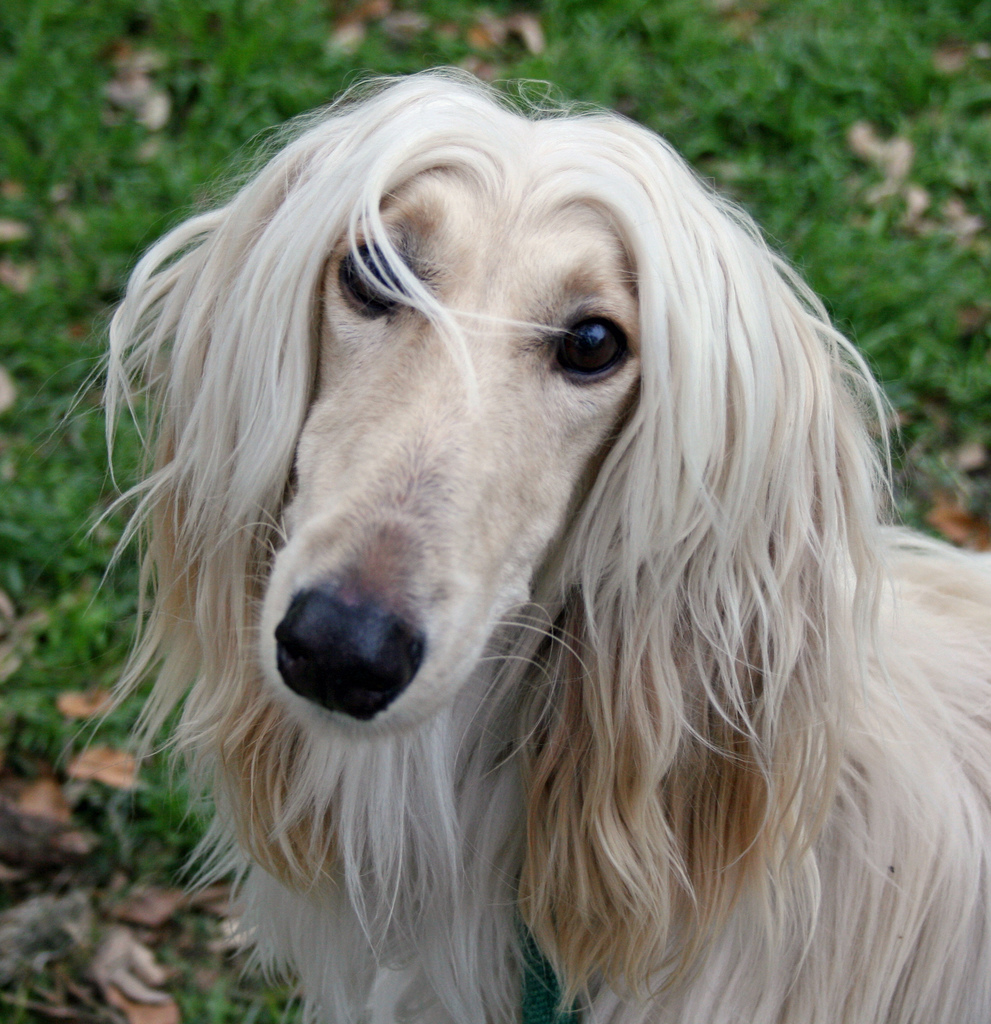

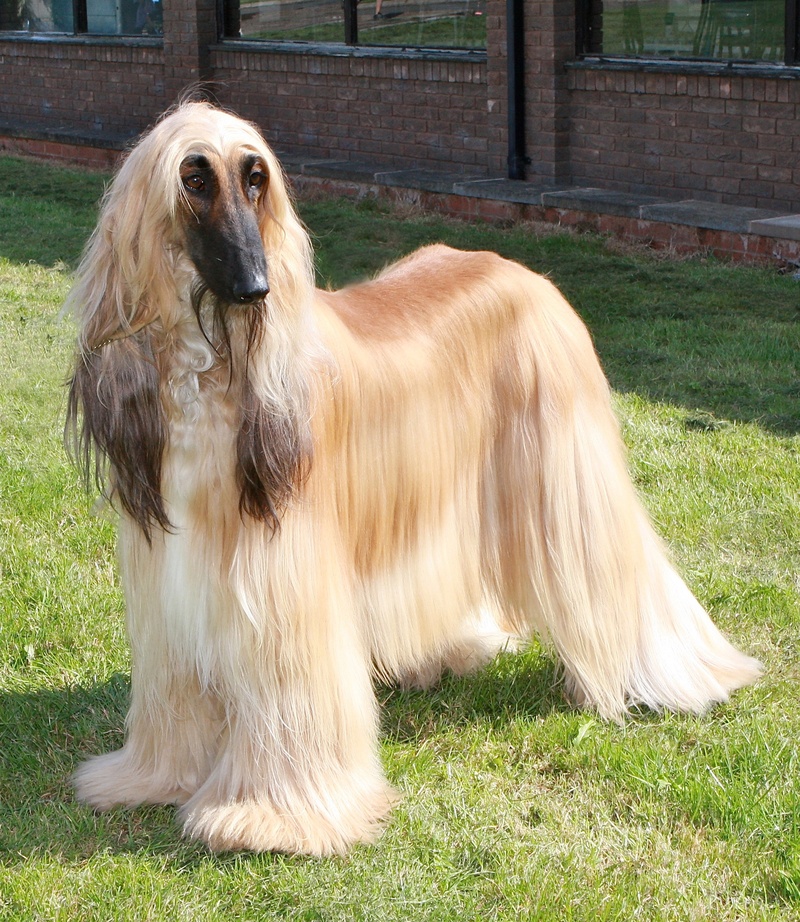

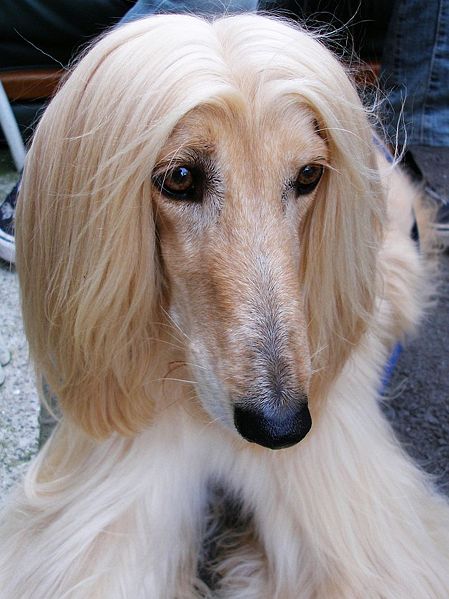
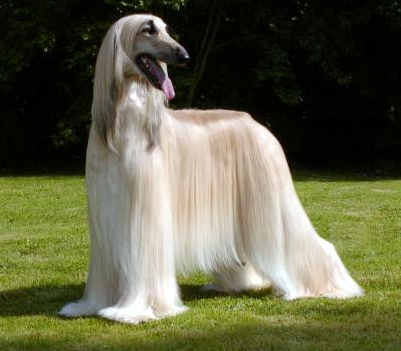

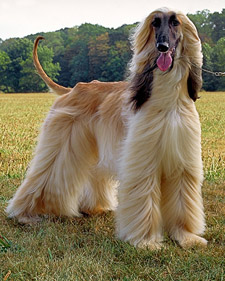
 Animalia Life
Animalia Life